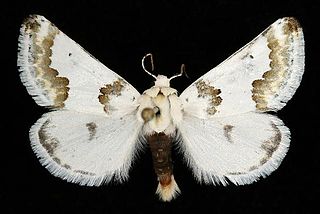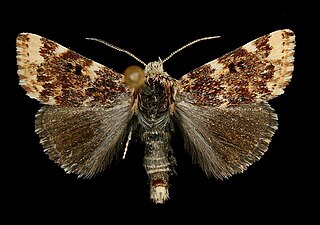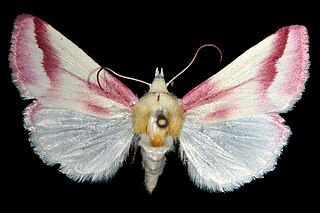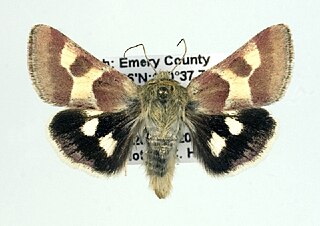
Schinia, commonly called flower moths, is a large genus of moths belonging to the family Noctuidae. The genus has a Holarctic distribution with the vast majority of species being found in North America, many with a very restricted range and larval food plant.
Abagrotis duanca is a moth of the family Noctuidae first described by Smith in 1908. It is found in the Pacific Northwest of North America. In Alberta it has been collected only in the extreme southeastern corner.

Hemileuca hera, the sagebrush sheep moth or Hera buckmoth, is a moth of the family Saturniidae. The species was first described by Thaddeus William Harris in 1841. It is found in North America from southern Saskatchewan west to British Columbia, south to Arizona and New Mexico.

Schinia arcigera, the arcigera flower moth, is a moth of the family Noctuidae. The species was first described by Achille Guenée in 1852. It is found in North America from Nova Scotia to Florida, west to Arizona and Idaho, north to Saskatchewan.

Schinia jaguarina, the jaguar flower moth, is a moth of the family Noctuidae. The species was first described by Achille Guenée in 1852. It is found on North America's Great Plains from Saskatchewan and Alberta south to Texas, eastward on coast to Florida and westward in south to Arizona. In Mexico it is found down to Mexico City.

Schinia roseitincta is a moth of the family Noctuidae first described by Leon F. Harvey in 1875. It is found in the northern United States and in Canada.

Schinia cumatilis, the silver-banded gem, is a moth of the family Noctuidae. The species was first described by Augustus Radcliffe Grote in 1865. It is found from the Southwestern United States into Southern Canada.

Schinia honesta, or the black-spotted gem, is a moth of the family Noctuidae. The species was first described by Augustus Radcliffe Grote in 1881. It is found in southern Canada and California. The wingspan is about 25–26 mm.
Schinia verna, or the Verna's flower moth, is a moth of the family Noctuidae. It is found in Alberta, Saskatchewan and Manitoba.

Schinia accessa is a moth of the family Noctuidae. It is found in Texas, southern Arizona, Colorado and Mexico.

Schinia meadi, or Mead's flower moth, is a moth of the family Noctuidae. The species was first described by Augustus Radcliffe Grote in 1873. It is found in western North America from south central Saskatchewan and central Alberta west to south central Washington, south to Arizona and New Mexico.

Schinia avemensis, the gold-edged gem, is a moth of the family Noctuidae. The species was first described by Harrison Gray Dyar Jr. in 1904. It is found in only three colonies in the southern prairie provinces of Canada, the Spirit Dunes at Spruce Woods Provincial Park, Manitoba; the Burstall dunes in south-western Saskatchewan; and in a small dune complex in the Red Deer River valley north of Bindloss. It will probably also be found in other active dune complexes in the southern parts of Alberta and Saskatchewan. It has also been recorded from Colorado.

Schinia gaurae, the clouded crimson, is a moth of the family Noctuidae. The species was first described by James Edward Smith in 1797. It is found in North America from Illinois west across southern Saskatchewan and Alberta, south to Florida, Texas, Arizona and south into Mexico.

Schinia nuchalis, the spotted sage moth, is a moth of the family Noctuidae. The species was first described by Augustus Radcliffe Grote in 1878. It is found from the Great Plains and Great Basin, from southern Saskatchewan, Alberta and British Columbia south to northern Arizona. The Eurasian Schinia scutosa is no longer considered a synonym of Schinia nuchalis.
Schinia persimilis, the persimilis flower moth, is a moth of the family Noctuidae. The species was first described by Augustus Radcliffe Grote in 1873. It is found from in western North America from east central Alberta and the Cypress Hills in Saskatchewan north to the southern Yukon, west and south to Colorado, Utah, California and Oregon.

Schinia suetus is a moth of the family Noctuidae first described by Augustus Radcliffe Grote in 1873. It is widespread in the mountains of western North America, from southern Alberta west to British Columbia, south at least to Colorado and California, east to Idaho and New Mexico.

Schinia villosa, the little dark gem, is a moth of the family Noctuidae. The species was first described by Augustus Radcliffe Grote in 1864. In North America, it is mostly a western mountain species, however it has also been found across the plains eastward across Alberta and Saskatchewan to southern Manitoba. To the west it is found up to the coast ranges of Washington and British Columbia, south to Arizona.

Schinia scutosa, the spotted clover, is a moth of the family Noctuidae. It is found from Europe to southern Siberia, the Near East and the Middle East and from central Asia to Japan. In North Africa it is found from Morocco to Egypt.

Synchlora aerata, the wavy-lined emerald moth or camouflaged looper, is a species of moth of the family Geometridae. The species was described by Johan Christian Fabricius in 1798. It is found in most of North America.















